ECU CHEVROLET ASTRO 2005 User Guide
[x] Cancel search | Manufacturer: CHEVROLET, Model Year: 2005, Model line: ASTRO, Model: CHEVROLET ASTRO 2005Pages: 376, PDF Size: 2.45 MB
Page 57 of 376
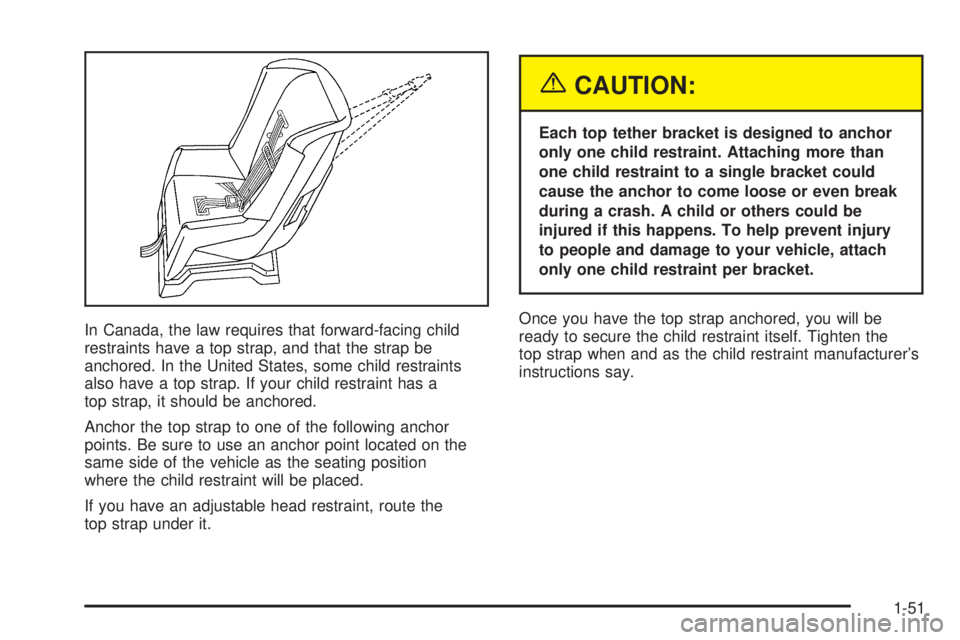
In Canada, the law requires that forward-facing child
restraints have a top strap, and that the strap be
anchored. In the United States, some child restraints
also have a top strap. If your child restraint has a
top strap, it should be anchored.
Anchor the top strap to one of the following anchor
points. Be sure to use an anchor point located on the
same side of the vehicle as the seating position
where the child restraint will be placed.
If you have an adjustable head restraint, route the
top strap under it.
{CAUTION:
Each top tether bracket is designed to anchor
only one child restraint. Attaching more than
one child restraint to a single bracket could
cause the anchor to come loose or even break
during a crash. A child or others could be
injured if this happens. To help prevent injury
to people and damage to your vehicle, attach
only one child restraint per bracket.
Once you have the top strap anchored, you will be
ready to secure the child restraint itself. Tighten the
top strap when and as the child restraint manufacturer’s
instructions say.
1-51
Page 58 of 376
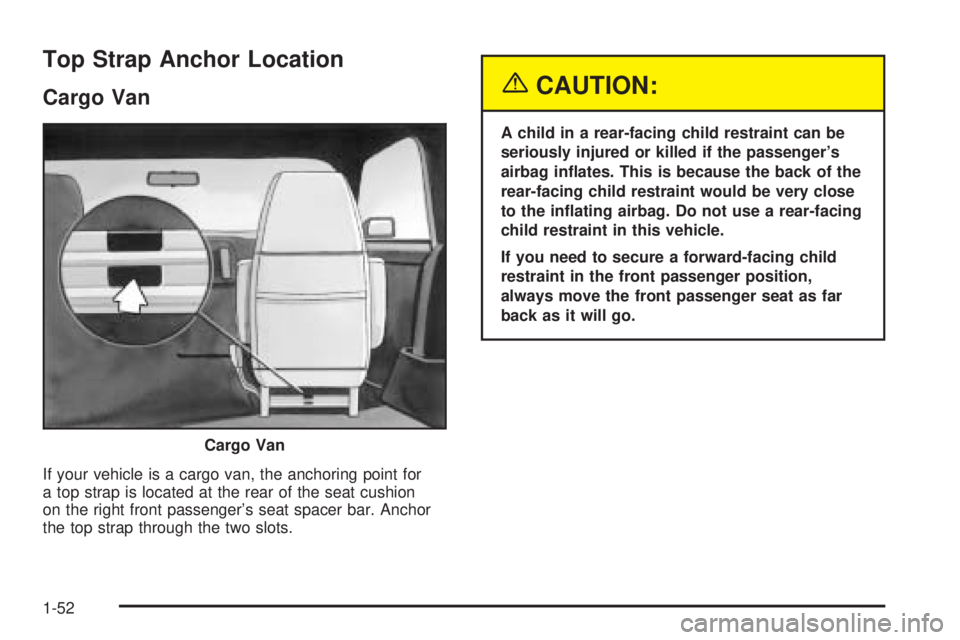
Top Strap Anchor Location
Cargo Van
If your vehicle is a cargo van, the anchoring point for
a top strap is located at the rear of the seat cushion
on the right front passenger’s seat spacer bar. Anchor
the top strap through the two slots.
{CAUTION:
A child in a rear-facing child restraint can be
seriously injured or killed if the passenger’s
airbag in�ates. This is because the back of the
rear-facing child restraint would be very close
to the in�ating airbag. Do not use a rear-facing
child restraint in this vehicle.
If you need to secure a forward-facing child
restraint in the front passenger position,
always move the front passenger seat as far
back as it will go.
Cargo Van
1-52
Page 60 of 376
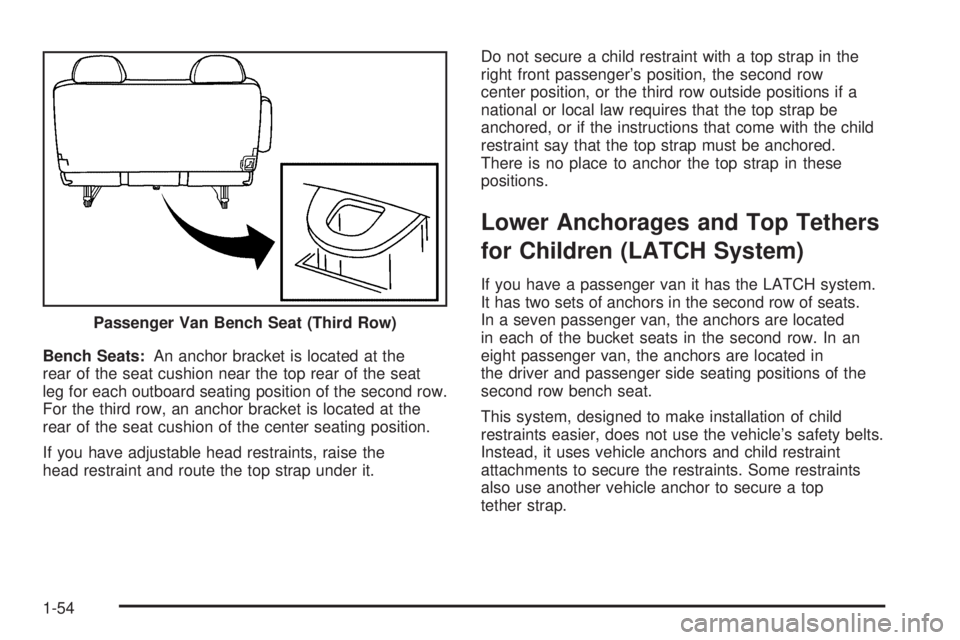
Bench Seats:An anchor bracket is located at the
rear of the seat cushion near the top rear of the seat
leg for each outboard seating position of the second row.
For the third row, an anchor bracket is located at the
rear of the seat cushion of the center seating position.
If you have adjustable head restraints, raise the
head restraint and route the top strap under it.Do not secure a child restraint with a top strap in the
right front passenger’s position, the second row
center position, or the third row outside positions if a
national or local law requires that the top strap be
anchored, or if the instructions that come with the child
restraint say that the top strap must be anchored.
There is no place to anchor the top strap in these
positions.
Lower Anchorages and Top Tethers
for Children (LATCH System)
If you have a passenger van it has the LATCH system.
It has two sets of anchors in the second row of seats.
In a seven passenger van, the anchors are located
in each of the bucket seats in the second row. In an
eight passenger van, the anchors are located in
the driver and passenger side seating positions of the
second row bench seat.
This system, designed to make installation of child
restraints easier, does not use the vehicle’s safety belts.
Instead, it uses vehicle anchors and child restraint
attachments to secure the restraints. Some restraints
also use another vehicle anchor to secure a top
tether strap. Passenger Van Bench Seat (Third Row)
1-54
Page 61 of 376
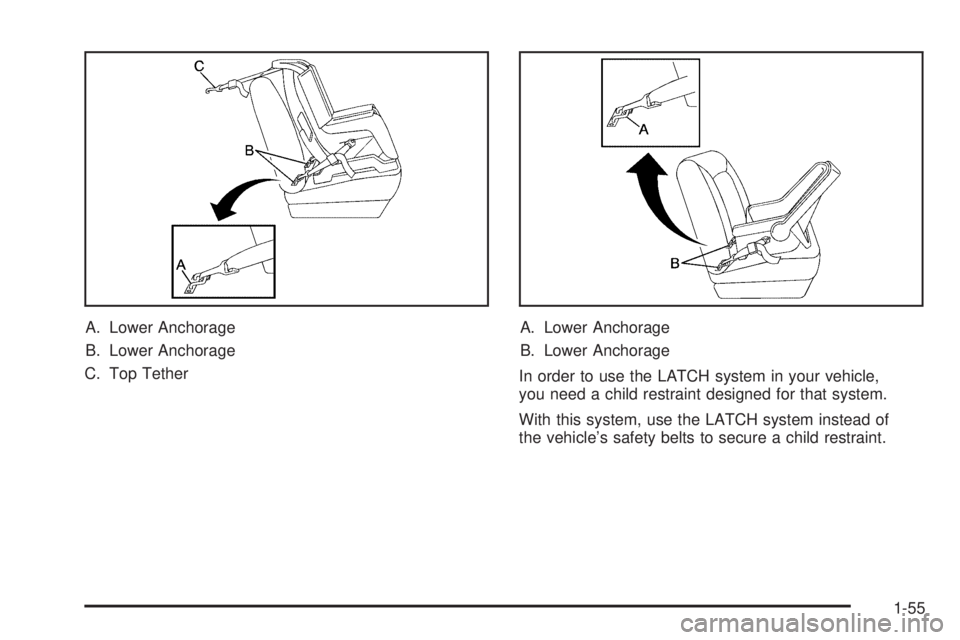
A. Lower Anchorage
B. Lower Anchorage
C. Top TetherA. Lower Anchorage
B. Lower Anchorage
In order to use the LATCH system in your vehicle,
you need a child restraint designed for that system.
With this system, use the LATCH system instead of
the vehicle’s safety belts to secure a child restraint.
1-55
Page 62 of 376
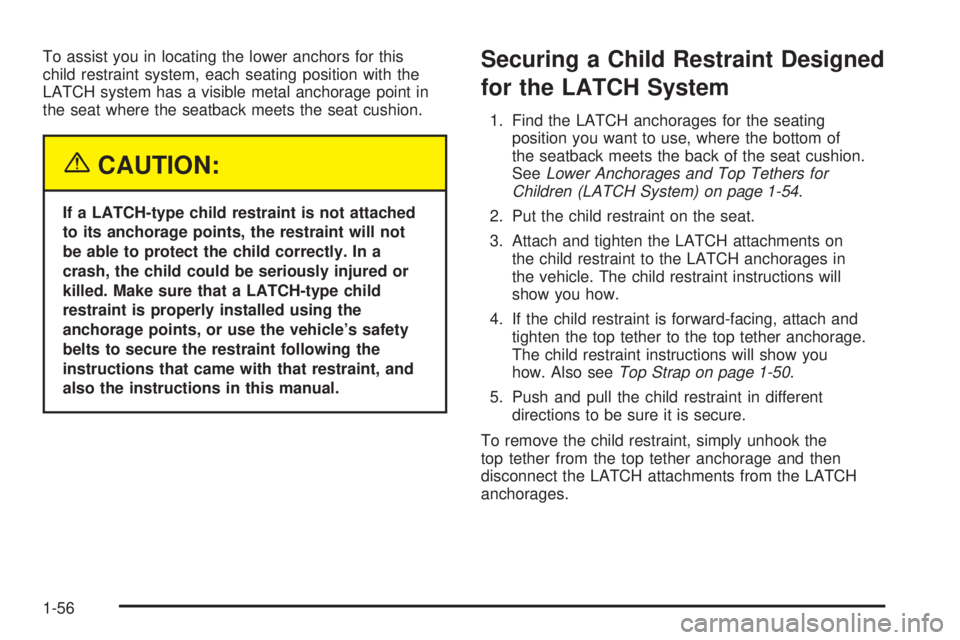
To assist you in locating the lower anchors for this
child restraint system, each seating position with the
LATCH system has a visible metal anchorage point in
the seat where the seatback meets the seat cushion.
{CAUTION:
If a LATCH-type child restraint is not attached
to its anchorage points, the restraint will not
be able to protect the child correctly. In a
crash, the child could be seriously injured or
killed. Make sure that a LATCH-type child
restraint is properly installed using the
anchorage points, or use the vehicle’s safety
belts to secure the restraint following the
instructions that came with that restraint, and
also the instructions in this manual.
Securing a Child Restraint Designed
for the LATCH System
1. Find the LATCH anchorages for the seating
position you want to use, where the bottom of
the seatback meets the back of the seat cushion.
SeeLower Anchorages and Top Tethers for
Children (LATCH System) on page 1-54.
2. Put the child restraint on the seat.
3. Attach and tighten the LATCH attachments on
the child restraint to the LATCH anchorages in
the vehicle. The child restraint instructions will
show you how.
4. If the child restraint is forward-facing, attach and
tighten the top tether to the top tether anchorage.
The child restraint instructions will show you
how. Also seeTop Strap on page 1-50.
5. Push and pull the child restraint in different
directions to be sure it is secure.
To remove the child restraint, simply unhook the
top tether from the top tether anchorage and then
disconnect the LATCH attachments from the LATCH
anchorages.
1-56
Page 63 of 376
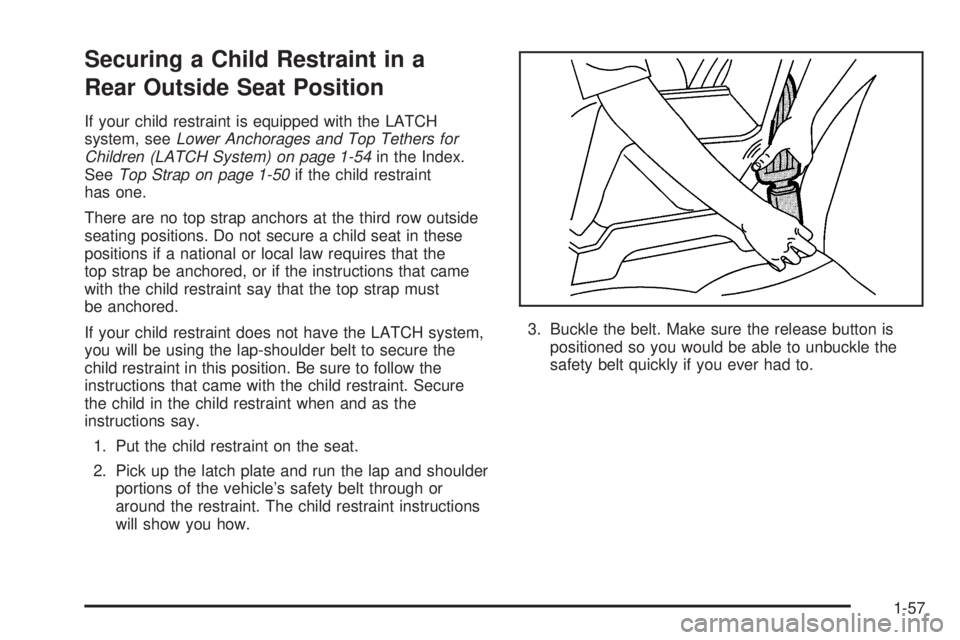
Securing a Child Restraint in a
Rear Outside Seat Position
If your child restraint is equipped with the LATCH
system, seeLower Anchorages and Top Tethers for
Children (LATCH System) on page 1-54in the Index.
SeeTop Strap on page 1-50if the child restraint
has one.
There are no top strap anchors at the third row outside
seating positions. Do not secure a child seat in these
positions if a national or local law requires that the
top strap be anchored, or if the instructions that came
with the child restraint say that the top strap must
be anchored.
If your child restraint does not have the LATCH system,
you will be using the lap-shoulder belt to secure the
child restraint in this position. Be sure to follow the
instructions that came with the child restraint. Secure
the child in the child restraint when and as the
instructions say.
1. Put the child restraint on the seat.
2. Pick up the latch plate and run the lap and shoulder
portions of the vehicle’s safety belt through or
around the restraint. The child restraint instructions
will show you how.3. Buckle the belt. Make sure the release button is
positioned so you would be able to unbuckle the
safety belt quickly if you ever had to.
1-57
Page 64 of 376
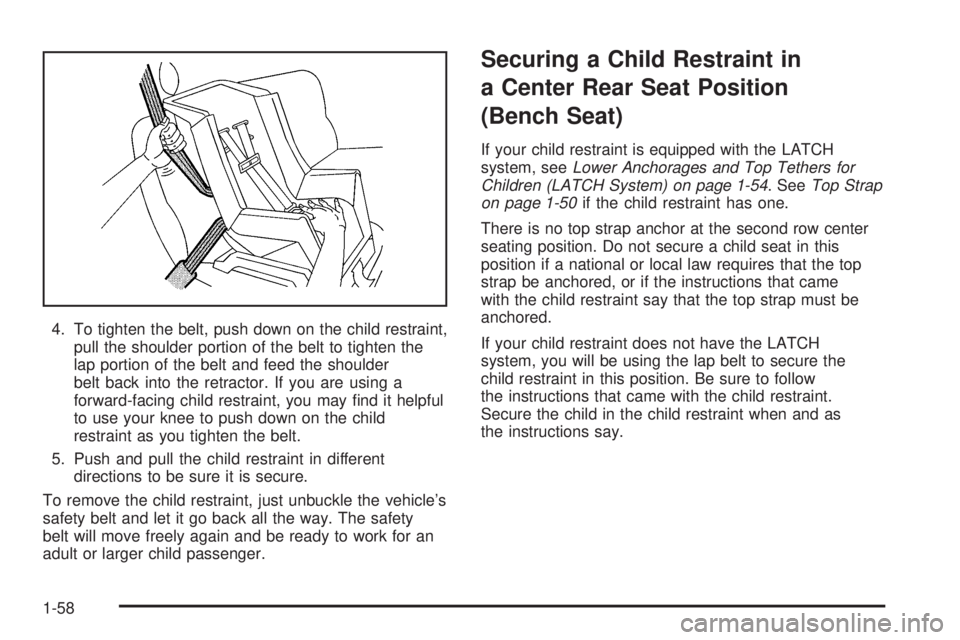
4. To tighten the belt, push down on the child restraint,
pull the shoulder portion of the belt to tighten the
lap portion of the belt and feed the shoulder
belt back into the retractor. If you are using a
forward-facing child restraint, you may �nd it helpful
to use your knee to push down on the child
restraint as you tighten the belt.
5. Push and pull the child restraint in different
directions to be sure it is secure.
To remove the child restraint, just unbuckle the vehicle’s
safety belt and let it go back all the way. The safety
belt will move freely again and be ready to work for an
adult or larger child passenger.
Securing a Child Restraint in
a Center Rear Seat Position
(Bench Seat)
If your child restraint is equipped with the LATCH
system, seeLower Anchorages and Top Tethers for
Children (LATCH System) on page 1-54. SeeTop Strap
on page 1-50if the child restraint has one.
There is no top strap anchor at the second row center
seating position. Do not secure a child seat in this
position if a national or local law requires that the top
strap be anchored, or if the instructions that came
with the child restraint say that the top strap must be
anchored.
If your child restraint does not have the LATCH
system, you will be using the lap belt to secure the
child restraint in this position. Be sure to follow
the instructions that came with the child restraint.
Secure the child in the child restraint when and as
the instructions say.
1-58
Page 65 of 376
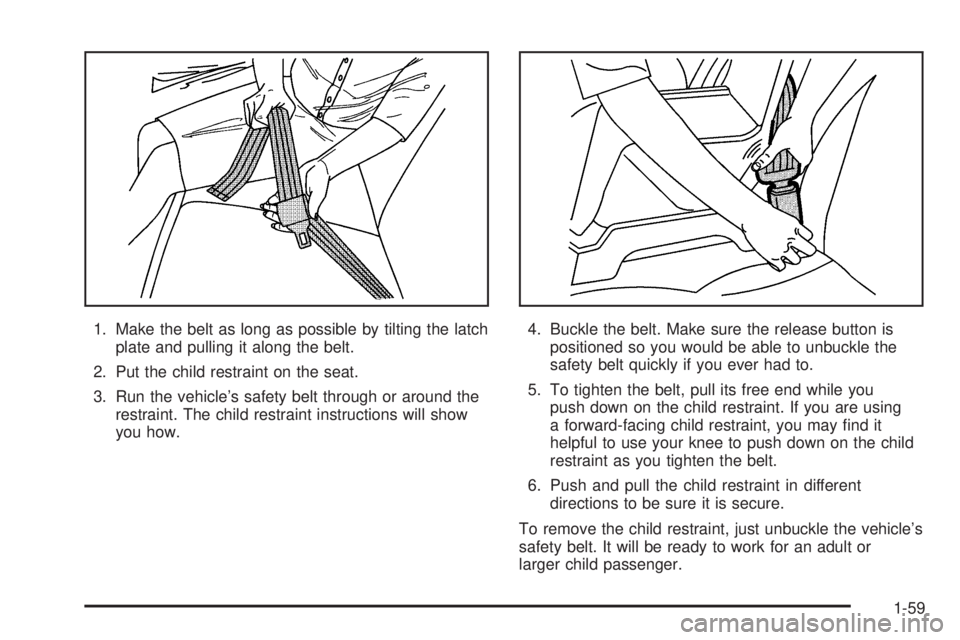
1. Make the belt as long as possible by tilting the latch
plate and pulling it along the belt.
2. Put the child restraint on the seat.
3. Run the vehicle’s safety belt through or around the
restraint. The child restraint instructions will show
you how.4. Buckle the belt. Make sure the release button is
positioned so you would be able to unbuckle the
safety belt quickly if you ever had to.
5. To tighten the belt, pull its free end while you
push down on the child restraint. If you are using
a forward-facing child restraint, you may �nd it
helpful to use your knee to push down on the child
restraint as you tighten the belt.
6. Push and pull the child restraint in different
directions to be sure it is secure.
To remove the child restraint, just unbuckle the vehicle’s
safety belt. It will be ready to work for an adult or
larger child passenger.
1-59
Page 66 of 376
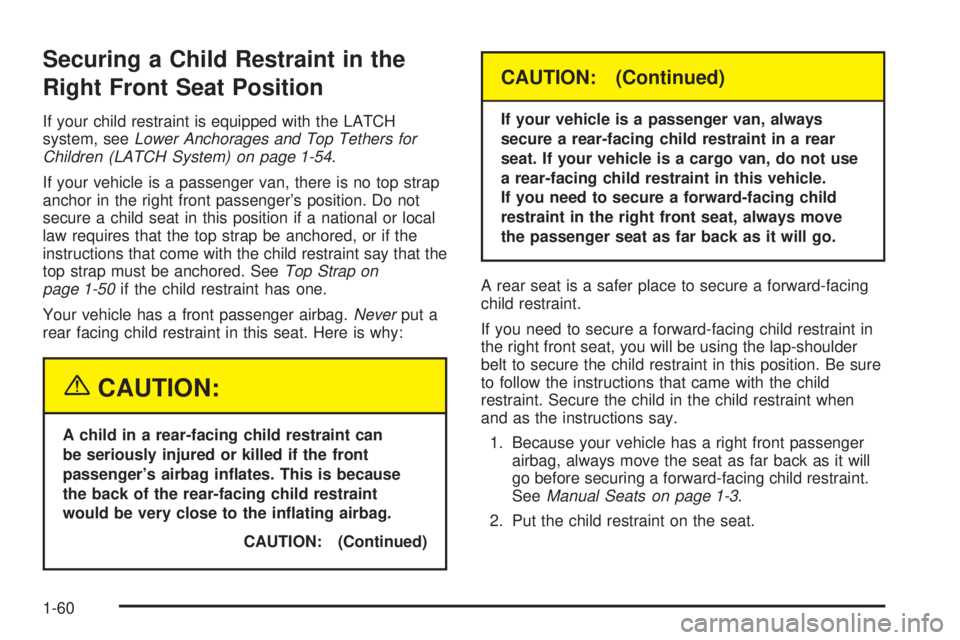
Securing a Child Restraint in the
Right Front Seat Position
If your child restraint is equipped with the LATCH
system, seeLower Anchorages and Top Tethers for
Children (LATCH System) on page 1-54.
If your vehicle is a passenger van, there is no top strap
anchor in the right front passenger’s position. Do not
secure a child seat in this position if a national or local
law requires that the top strap be anchored, or if the
instructions that come with the child restraint say that the
top strap must be anchored. SeeTop Strap on
page 1-50if the child restraint has one.
Your vehicle has a front passenger airbag.Neverput a
rear facing child restraint in this seat. Here is why:
{CAUTION:
A child in a rear-facing child restraint can
be seriously injured or killed if the front
passenger’s airbag in�ates. This is because
the back of the rear-facing child restraint
would be very close to the in�ating airbag.
CAUTION: (Continued)
CAUTION: (Continued)
If your vehicle is a passenger van, always
secure a rear-facing child restraint in a rear
seat. If your vehicle is a cargo van, do not use
a rear-facing child restraint in this vehicle.
If you need to secure a forward-facing child
restraint in the right front seat, always move
the passenger seat as far back as it will go.
A rear seat is a safer place to secure a forward-facing
child restraint.
If you need to secure a forward-facing child restraint in
the right front seat, you will be using the lap-shoulder
belt to secure the child restraint in this position. Be sure
to follow the instructions that came with the child
restraint. Secure the child in the child restraint when
and as the instructions say.
1. Because your vehicle has a right front passenger
airbag, always move the seat as far back as it will
go before securing a forward-facing child restraint.
SeeManual Seats on page 1-3.
2. Put the child restraint on the seat.
1-60
Page 68 of 376
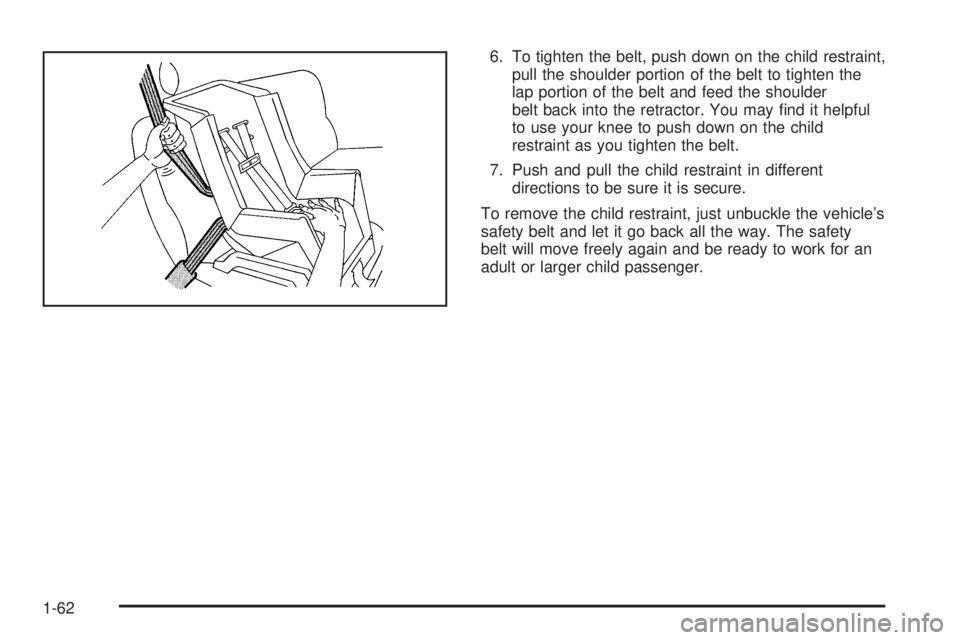
6. To tighten the belt, push down on the child restraint,
pull the shoulder portion of the belt to tighten the
lap portion of the belt and feed the shoulder
belt back into the retractor. You may �nd it helpful
to use your knee to push down on the child
restraint as you tighten the belt.
7. Push and pull the child restraint in different
directions to be sure it is secure.
To remove the child restraint, just unbuckle the vehicle’s
safety belt and let it go back all the way. The safety
belt will move freely again and be ready to work for an
adult or larger child passenger.
1-62